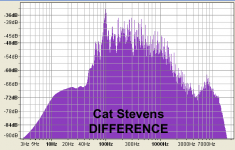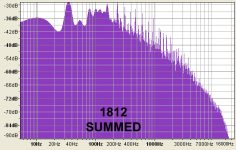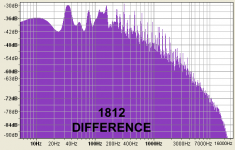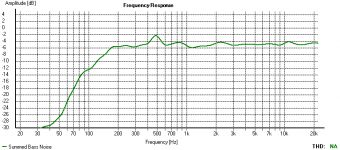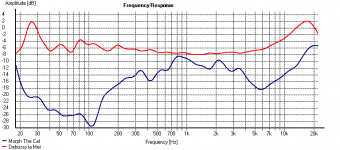I agree with you there, Bear.
But if the majority of recordings are mixed to mono in the bass, then the majority of people can do just fine with mono subs. I'm just not sure that most bass is mixed to mono on CDs. I've been finding that it isn't, but I could be looking at it wrong. Earl thinks my method is flawed, so I'm trying hard to find the flaws.
But if the majority of recordings are mixed to mono in the bass, then the majority of people can do just fine with mono subs. I'm just not sure that most bass is mixed to mono on CDs. I've been finding that it isn't, but I could be looking at it wrong. Earl thinks my method is flawed, so I'm trying hard to find the flaws.
I agree with you there, Bear.
But if the majority of recordings are mixed to mono in the bass, then the majority of people can do just fine with mono subs. I'm just not sure that most bass is mixed to mono on CDs. I've been finding that it isn't, but I could be looking at it wrong. Earl thinks my method is flawed, so I'm trying hard to find the flaws.
Mixed to mono or effectively mono due to small inter-mike distances? Between the two I'd think there's a LOT of mono. I'll be interested to see how your experimentation shapes up- I'd always assumed the "CDs are almost always mono in bass" to be accurate.
Take the ripped CD into one of the software editing packages, apply a LP filter, sum with one channel inverted... if it is mono the result is a null.
Of course with real bass and stereo, it is possible for the two channels to be pretty close together in time/phase, but not exactly.
I think it is tough to figure this out reliably, except that truly mono'd bass will result in an absolute nulling...
but as I said, I don't care, since at least for myself I have deluded and convinced myself that I can hear the difference in the sound field when I get my subs (presumably) lined up (like ducks...) time/phase wise.
I am still waiting for the speakers with zero phase shift and zero grope delay.
_-_-
Of course with real bass and stereo, it is possible for the two channels to be pretty close together in time/phase, but not exactly.
I think it is tough to figure this out reliably, except that truly mono'd bass will result in an absolute nulling...
but as I said, I don't care, since at least for myself I have deluded and convinced myself that I can hear the difference in the sound field when I get my subs (presumably) lined up (like ducks...) time/phase wise.
I am still waiting for the speakers with zero phase shift and zero grope delay.
_-_-
Hey, I was thinking about this...
Take ur mono sub (or stereo) and move it/them about 50% or more of the distance toward your listening position. Adjust the level down to match the amplitude of the original position (if you want).
Now play a recording with maybe solo drums...actually a good one is Gates Of Dafos, Mickey Hart's album Dafos... he hits a VERY large drum skin with a stick. So, you have the stick hit and the rumble, in stereo.
By moving the sub forward, you start to get the *rumble* start before the stick hit. See how that sounds. Now move the sub rearward (or subs) until you can notice the drum materializing as a single entity between your speakers. (assuming that things actually can and do materialize in space between your speakers in the first place).
Yes, the degree of movement in this experiment is somewhat exaggerated, IF you are of the school that thinks the time alignment matters. But IF ur not of that school, then you ought to hear no real differences?
What do you think?
Take ur mono sub (or stereo) and move it/them about 50% or more of the distance toward your listening position. Adjust the level down to match the amplitude of the original position (if you want).
Now play a recording with maybe solo drums...actually a good one is Gates Of Dafos, Mickey Hart's album Dafos... he hits a VERY large drum skin with a stick. So, you have the stick hit and the rumble, in stereo.
By moving the sub forward, you start to get the *rumble* start before the stick hit. See how that sounds. Now move the sub rearward (or subs) until you can notice the drum materializing as a single entity between your speakers. (assuming that things actually can and do materialize in space between your speakers in the first place).
Yes, the degree of movement in this experiment is somewhat exaggerated, IF you are of the school that thinks the time alignment matters. But IF ur not of that school, then you ought to hear no real differences?
What do you think?
Bear, that's what I did, and more. Earl s says it's not accurate. Still working on it.
Alright then.
What we need are some controls.
Take a known MONO recording.
Do the same thing with that.
Also set the LP to say 60Hz. or less. Remove ambiguity.
One can also simply *record* a mono signal on two tracks and burn that. One version can be sig gen tones, the other a cheap keyboard recorded.
Both will Null when inverted. Add the LP filter and try again.
If that also nulls, then we pretty sure can say the test works.
What I think is getting lost here is what we each mean by "mono". There is a continuum here IMO with pure mono being one extreme. So when you do you "null" test are you saying that anything that does not null to zero (-infinite dB) is not mono? Because to me if the signal is only a little different then its still blended mono, just not absolutely mono. this would occur at anything less than -10 dB signal difference. This is why I don't like using this "difference" test as there are too many questions and possible differences of scale. With cross-correlation you get a single unambiguous number that doesn't depend on exact phase timing or signal level, both of which your test is very sensitive to.
I look at Pano's data and I see mono blending. I am sure that he doesn't however. It is a matter of degrees and interpretation. How much separation does there have to be for something to be "stereo"?
I look at Pano's data and I see mono blending. I am sure that he doesn't however. It is a matter of degrees and interpretation. How much separation does there have to be for something to be "stereo"?
Yep Bear, I've done all that. It works as you have stated. I can see a degree of mono summing in some recordings, not in others. Of course there is nothing left on true mono recordings. I will post results in a bit.
That's a good question, and one we haven't answered yet. I don't know.How much separation does there have to be for something to be "stereo"?
Perhaps if we look at the relative levels in different bands of the spectrum analysis it will give us a good idea. I have some interesting results that I'll post in a few minutes.
Cat Stevens
OK, here is FT of a bit of Cat Stevens summed to mono and also with one channel flipped and then summed to mono. Maybe not the greatest choice, as there isn't much low bass, but just something I picked.
I do see what appears to be mono summing on this one. Look how much faster the difference file drops off under ~90Hz.
OK, here is FT of a bit of Cat Stevens summed to mono and also with one channel flipped and then summed to mono. Maybe not the greatest choice, as there isn't much low bass, but just something I picked.
I do see what appears to be mono summing on this one. Look how much faster the difference file drops off under ~90Hz.
Attachments
And here is another way of looking at it. The summed and the difference files were imported into HOLMImpulse and correlated. The graph shows the levels of stereo vs mono.
The bass summing Cat Stevens is easier to see here, and seems to start quite high.
(I hope I've done this right, take it with a grain of salt until I double check.)
The bass summing Cat Stevens is easier to see here, and seems to start quite high.
(I hope I've done this right, take it with a grain of salt until I double check.)
Attachments
Here we go with the made up definitions again. "Blended mono" is not mono.
Mono is mono.
A monophonic sound may be recorded simultaneously by 2 microphones with some physical separation. No matter how close the microphones are the effect will still be stereo.
Geez louise, the bass in a stereo track will be "almost" identical, as it is the same sound being recorded by both channels.
Nice work Pano.
Mono is mono.
A monophonic sound may be recorded simultaneously by 2 microphones with some physical separation. No matter how close the microphones are the effect will still be stereo.
Geez louise, the bass in a stereo track will be "almost" identical, as it is the same sound being recorded by both channels.
Nice work Pano.
Pano
Not the way that I would have done it, but I can accept those results. it would appear that classical recordings are not blended but most popular music might be. When we did our test we never tested any classical recordings. It wasn't our interest.
That still leaves the question: what is stereo? Is 1dB separation stereo? It's not to me. As I said the situation is clearly a continuum with stereo at one extreme and mono at the other. Most likely not much will exist at either extreme making. So what does all this mean? I'm loosing the point.
Not the way that I would have done it, but I can accept those results. it would appear that classical recordings are not blended but most popular music might be. When we did our test we never tested any classical recordings. It wasn't our interest.
That still leaves the question: what is stereo? Is 1dB separation stereo? It's not to me. As I said the situation is clearly a continuum with stereo at one extreme and mono at the other. Most likely not much will exist at either extreme making. So what does all this mean? I'm loosing the point.
I'm not sure if 1dB would be or not: we'd need to do some listening tests or something...
You guys have heard the Sound Check disc, right? By Alan Parsons and Stephen Court?
The "full drum kit" track toward the end has, at the beginning, 4 toms that are hit, and sound as if they're spread between the speakers in front of me. None would appear to be hard-panned to one speaker, nor are any dead-centre.
What're the level differences between the two channels for each drum?
I'd expect reasonably small differences for the middle two toms, and maybe 6-9dB for the outer ones, but I honestly have no idea.
Pano, would you be able to run that through your software?
Cheers
Chris
You guys have heard the Sound Check disc, right? By Alan Parsons and Stephen Court?
The "full drum kit" track toward the end has, at the beginning, 4 toms that are hit, and sound as if they're spread between the speakers in front of me. None would appear to be hard-panned to one speaker, nor are any dead-centre.
What're the level differences between the two channels for each drum?
I'd expect reasonably small differences for the middle two toms, and maybe 6-9dB for the outer ones, but I honestly have no idea.
Pano, would you be able to run that through your software?
Cheers
Chris
Generally the case . . . with the caveat that much of the "classical" catalog was recorded with at least one (and often the primary) mic being either a coincident or near coincident pair that sums the bass anyway. It was (and is) just not "normal" to record an orchestra in a dry studio with spot mics and mix half the band (including basses and bassoons) in one channel and the other half in the other. You <B>always</B> had to mix with the reality of vinyl in mind, and expecting that even your stereo recordings would be mixed to mono (and not just the bass) for radio broadcast.it would appear that classical recordings are not blended but most popular music might be.
It was the electric bass that pretty much forced mix-to-mono bass on rock and pop recordings, because it was just too loud to cut otherwise.
All of which is drifting a bit far from the original question regarding whether we can (at what frequency we can) localize bass consistent with the original position when reproduced in a small room, and whether stereo (two channel) subs do better at that than mono using either a single or distributed low bass speakers.
I'm not sure if 1dB would be or not: we'd need to do some listening tests or something...
Chris
I would suspect that you could not tell the difference between 1 dB separation and mono. Its just not enough of a difference to be significant.
Yes precisely. I had this same thought. There would be no need to blend the bass on a classical work. There just isn't enough LF energy to matter.It was the electric bass that pretty much forced mix-to-mono bass on rock and pop recordings, because it was just too loud to cut otherwise.
1 dB of separation?
How about it?
If you take an instrument that has been recorded mono and pan-pot it 1dB, will the apparent position move?
Wait, let's take two instruments, like two violins or maybe a viola playing high and a violin playing low (overlapping on the musical staff). How much pan-potted difference will make it audible that there are two instruments, separated by apparent left-right space in the mix?
How many dB will make the instrument appear to be virtually hard left or right?
😀
How about it?
If you take an instrument that has been recorded mono and pan-pot it 1dB, will the apparent position move?
Wait, let's take two instruments, like two violins or maybe a viola playing high and a violin playing low (overlapping on the musical staff). How much pan-potted difference will make it audible that there are two instruments, separated by apparent left-right space in the mix?
How many dB will make the instrument appear to be virtually hard left or right?
😀
- Status
- Not open for further replies.
- Home
- Member Areas
- The Lounge
- Can the human ear really localize bass?

